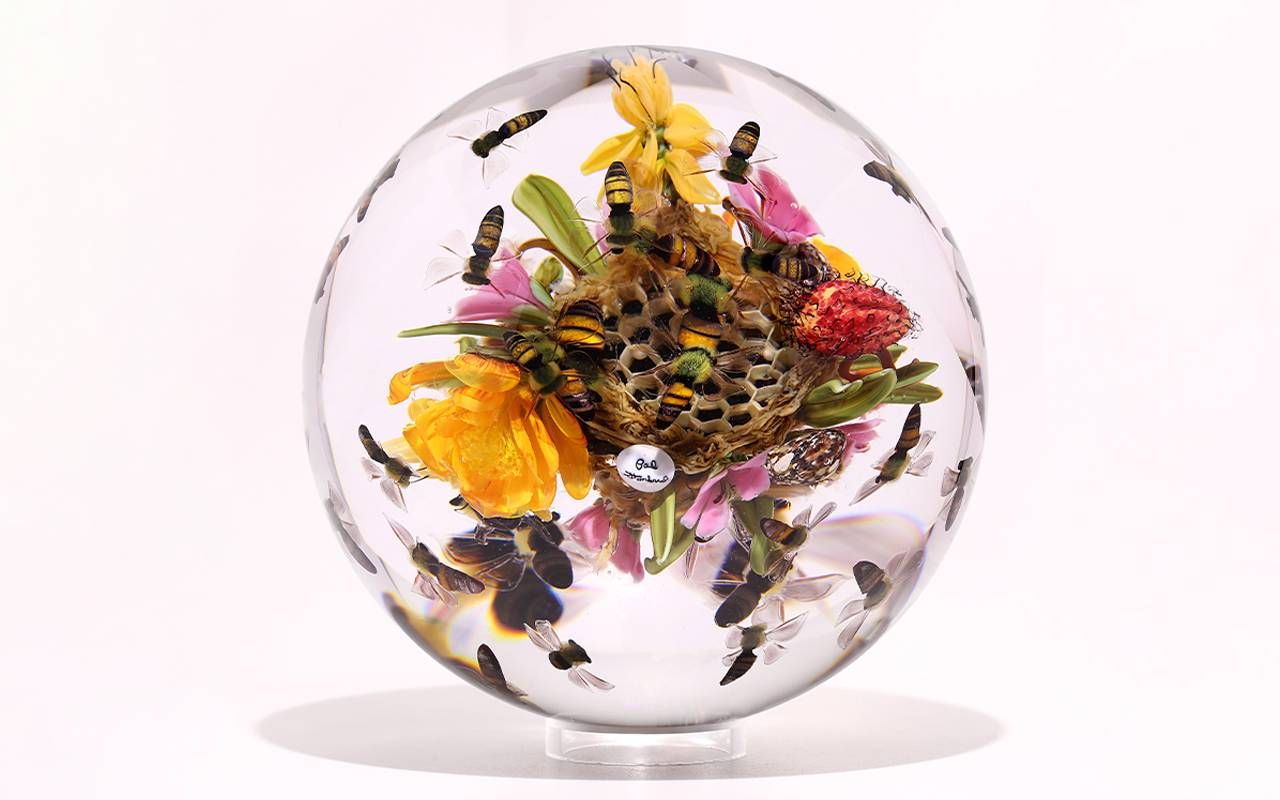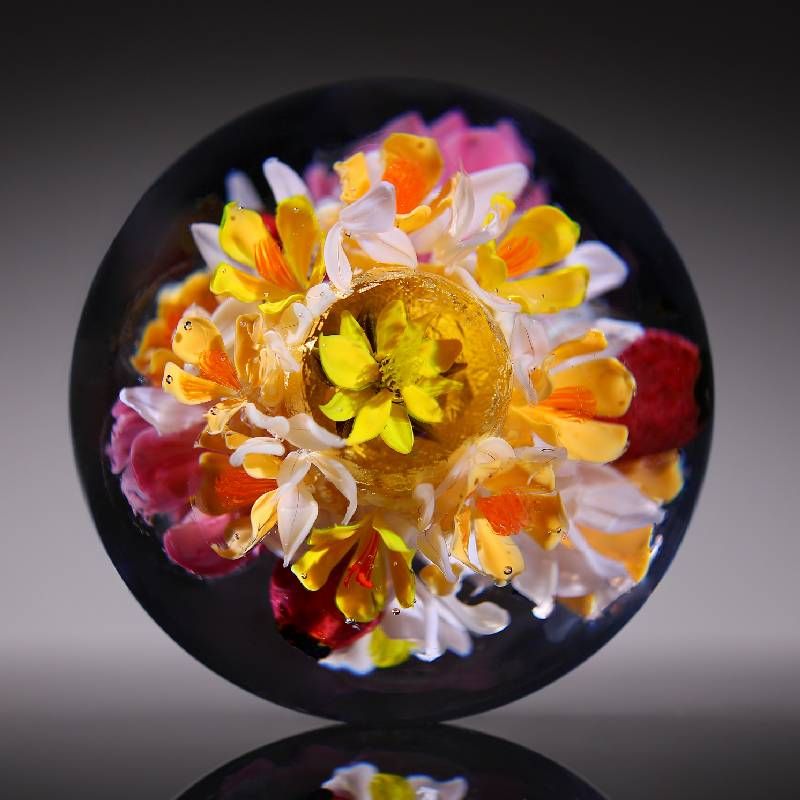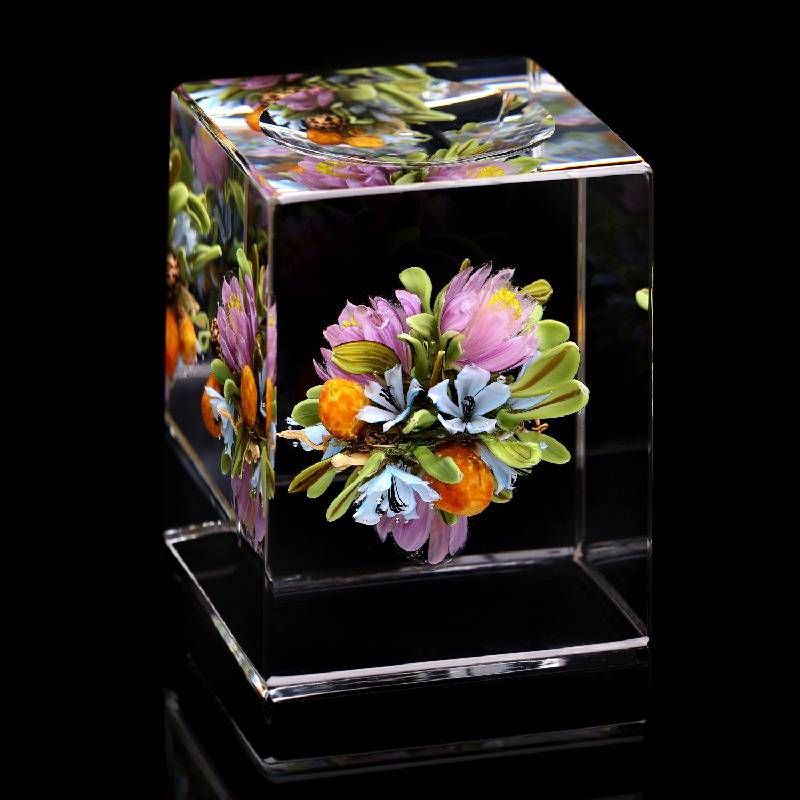How Studio Glass Artist Paul J. Stankard Interprets Nature
Now in his 80s, Paul J. Stankard is finding new audiences through a just-released documentary, a new book and a major museum retrospective
There are typical glass paperweights and then there are the works of glass art created by Paul J. Stankard. One of the most influential artists to emerge from the Studio Glass movement, Stankard crafts three-dimensional sculptural works with all elements produced individually in glass using a technique called flamework. His pieces — in which flowers, leaves and natural elements like honeybees seem to float in glass — can be seen in more than 75 museums around the world and command prices upwards of $45,000 each.

"It's a joy for me to see how people react to it. It's very labor intensive, but it can seem like magic."
Now in his 80s, the New Jersey-based artist is finding new audiences and new ways to give back. There's a just-released documentary film, a new book and a major museum retrospective, as well as honors from a local college and an arts center.
"It's amazing that all this is happening at once," says Stankard. "I'm having the best time."
Even two bouts with cancer over the past few years haven't really slowed him down. "I've been sitting behind a torch for more than 60 years, and I still have as much interest and enthusiasm and hopes for the future today as I had at the beginning," Stankard says. "It was so important to me to create a new way of interpreting nature in glass."
Inspired by Walt Whitman
Deeply inspired by the earthy and often spiritual writings of Walt Whitman, Stankard says one line from "Leaves of Grass" touches him deeply, and reminds him of the heart-and-mind process behind his own work: "The narrowest hinge in my hand puts to scorn all machinery." Indeed, no machine could ever replicate the enigmatic beauty of Stankard's glass creations.
Having started his career in industrial glass, Stankard wanted to be more imaginative, and discovered different ways of using the process of flameworking (also called lampworking). The technique involves forming objects from rods of colored glass that, when heated in a 1,800 degree flame, become pliable and can be shaped using simple tools.
"From Flame to Flower," a recent exhibition of his work at the Morris Museum in Morristown, New Jersey, traced the evolution of his art from the late 1960s through videos and physical displays.

"It's a joy for me to see how people react to it," Stankard says. "It's very labor intensive, but it can seem like magic."
The "magic" behind his work is a focus in his recently published book, "Inspiration from the Art of Paul J. Stankard: A Window into My Studio and Soul," which serves as both a colorful coffee table book and a guidebook of sorts for inspiring artists: "It's the book I wish I had when I was starting out," he says, adding that it will complement his work long after he is gone.
A five-year project, the book covers everything from building a routine to learning from failure to fusing spirituality with art-making.
Fascinated With Nature
Stankard's own road to success was a long and often arduous one. Born in 1943, he was fascinated with nature from an early age and was always "good with his hands," as his mother would tell him. Stankard's family moved from Massachusetts to New Jersey in the late 1950s, and he struggled through school as an undiagnosed dyslexic, graduating near the bottom of his high school class.

After graduation, his father encouraged him to enroll in a two-year scientific glass-blowing program at what is now called Salem Community College, in rural southern New Jersey, believing it could him land a good job, which it did. But the more skilled Stankard became, the more he felt the pull of his artistic side. It wasn't about the money: It was about his need to create, starting with simple glass animals he worked on during his lunch break or spare time.
With no living mentor to show him the way, Stankard acknowledges that he "pretty much reinvented the process of 19th century French paperweights." But instead of creating stylized flower patterns like the craftsmen of centuries past, Stankard copied nature, which he deeply cared about.
"Nature speaks to us on many levels," Stankard says. "It is universal and eternal."
By 1972, still in his twenties, Stankard made the risky decision to devote himself full time to his art, with the full support of his wife, Pat. While the father of five struggled to get his bearings the first year, he quickly developed a strong discipline for the actual work and the marketing of it. Over the next 20 years, Stankard's reputation grew worldwide, along with the demand, both domestically and abroad, for his creative output.
With their delicate and striking imagery of the plant world, Stankard's glass creations — he makes, on average, one each week – carry a strong emotional impact. He thinks that relates to the fact nature mirrors the life cycle of humans, saying his work, ultimately, is about "the biggies: sex, death and God."
Still Going Strong
Despite a recent bout with cancer, Stankard continues to teach at Salem Community College as artist-in-residence. In 2023, the school's Carney's Point, New Jersey campus unveiled a 15,000-square-foot studio/lab named in his honor. The inaugural Paul Stankard Flamework Fellowship was also announced; the Fellowship will be awarded this year to an emerging or mid-career artist "innovating and pushing the boundaries of artwork made with a torch."

Stankard says he gets tremendous personal pleasure from teaching, but says it also helps ensure the glass tradition will continue. David Graeber, Stankard's studio assistant for nearly 35 years, has benefited first-hand "through instruction and osmosis," as he says, from the master's passion for teaching.
Graeber, himself now a glass artist, first met Stankard when he was 18 years old, pumping gas. "To me, Paul's a hero and a genius," the 56-year-old Graeber says. "I dropped everything to work for him. It was the best decision I ever made."
More than a year ago, Graeber floated the idea of a documentary film about Stankard to Philadelphia area documentary filmmaker, Dan Collins. The resulting eight-month effort, "Paul J. Stankard: Flower & Flame" was recently completed. The first public screening was held in early February at the Morris Museum, which recently hosted a five-month long retrospective of Stankard's works.
"I go a little bit deeper, a little beyond, to capture the artist's spirit, both personally and professionally."
Another showing, held later that month at the Perkins Center for the Arts in Collingswood, New Jersey, drew a standing-room only crowd. The event also raised more than $10,000 (through ticket sales and a silent auction of a two Stankard paperweights) to be used to expand arts programming, including a new glass-making program for area veterans.
Collins is entering the documentary in dozens of festivals domestically and abroad. To date, it has been accepted for the 2024 Jersey Shore Film Festival – coming to three New Jersey towns in late June and early July.
"My style is to create a portrait of the artist through a conversational narrative. But I go a little bit deeper, a little beyond, to capture the artist's spirit, both personally and professionally," Collins said.
As for Stankard, he continues along his journey of self-education and reflection. He was invited to join a men's Bible study group last year, an experience he says has "spiritually energized my creative expressions in ways that have been very exciting."
"You can always keep learning," he says, "and I am."

